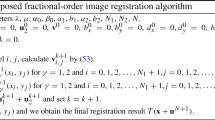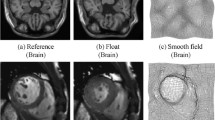Abstract
To solve the problem that the cost function of the classic free-form deformation (FFD) cannot simulate transformation field of images with large elastic deformation or local distortion in image registration better, and to increase the registration accuracy and robustness, a new non-rigid image registration method based on the classic hierarchical FFD is proposed. Since the smooth term has a significant influence on registration accuracy, and its coefficient is not easy to be controlled in the classic hierarchical B-spline based FFD, a L2-regularization term with faster and more stable optimization is introduced in the cost function of the proposed model. By coordinating the coefficients of this regularization term and the smooth term, this novel L2-regularized FFD model is able to solve the problem of low registration accuracy caused by strong smooth constraint while maintaining the images topologies. The introduced L2-regularization term can impose a spatial constraint on the control lattices transformation field, and the over-registration problem can be suppressed to a certain extent, so it can register the images with local large distortion. A series of registration experiments of natural images and medical images show that the new method has an obvious advantage over the classic model in registration accuracy measured by mean square error.








Similar content being viewed by others
References
Zitov, Barbara, Flusser, Jan: Image registration methods: a survey. Image Vis. Comput. 21(11), 9771000 (2003)
David, G.L.: Distinctive Image Features from Scale-Invariant Keypoints. Kluwer, Dordrecht (2004)
Du, S.: Scaling iterative closest point algorithm for registration of m–d point sets. J. Vis. Commun. Image Represent. 21(56), 442–452 (2010)
Bay, H., Ess, A., Tuytelaars, T., Van Gool, L.: Speeded-up robust features. Comput. Vis. Image. Underst. 110(3), 404–417 (2008)
Thirion, J.P.: Image matching as a diffusion process: an analogy with Maxwell’s demons. Med. Image Anal. 2(3), 243 (1998)
Wang, H., Dong, L.: Validation of an accelerated ‘demons’ algorithm for deformable image registration in radiation therapy. Phys. Med. Biol. 50(12), 2887–2905 (2005)
Xue, P., Yang, P.: An effective non-rigid image registration method based on active demons algorithm. Acta Autom. Sin. 42(9), 1389–1400 (2015)
Jia, D.: The Research of Non-rigid Registration Algorithm Based on Image Characteristics and Optical Flow. Master Thesis, ShanDong University
Pock, T., et al.: A duality based algorithm for TV- L, 1-optical-flow image registration. In: Medical Image Computing and Computer-Assisted Intervention - MICCAI 2007, pp. 511–518. Springer, Berlin, Heidelberg (2007)
Sun, D., Qiu, Z.: A new non-rigid image matching algorithm using thin-plate spline. Acta Electron. Sin. 30(8), 1104–1107 (2002)
Rueckert, D., Sonoda, L.I.: Nonrigid registration using free-form deformations: application to breast MR images. IEEE Trans. Med. Imaging 18(8), 712 (1999)
Wei, D.: Generalized sampling expansions with multiple sampling rates for lowpass and bandpass signals in the fractional fourier transform domain. IEEE Trans. Signal Process. 64(18), 4861–4874 (2016)
Wei, D.: Reconstruction of multidimensional bandlimited signals from multichannel samples in linear canonical transform domain. Signal Process. IET 8(6), 647–657 (2014)
Lee, S., Wolberg, G.: Scattered data interpolation with multilevel b-splines. IEEE Trans. Vis. Comput. Graph. 3(3), 228–244 (1997)
Wei, D.: Image super-resolution reconstruction using the high-order derivative interpolation associated with fractional filter functions. IET Signal Process. 10(9), 1052–1061 (2017)
Schnabel, J.A., Rueckert, D.: A generic framework for non-rigid registration based on non-uniform multi-level free-form deformations. In: International Conference on Medical Image Computing and Computer-Assisted Intervention, pp. 573–581 (2001)
Oliveira, F.P., Tavares, J.M.: Enhanced spatio-temporal alignment of plantar pressure image sequences using b-splines. Med. Biol. Eng. Comput. 51(3), 267–276 (2013)
Neumaier, Arnold: Solving ill-conditioned and singular linear systems: a tutorial on regularization. SIAM Rev. 40(3), 636–666 (1998)
Sun, D., Roth, S., Michael, J.B.: Secrets of optical flow estimation and their principles. In: Computer Vision and Pattern Recognition, pp. 2432–2439 (2010)
Zhang, S., Zhou, H.: Robust visual tracking using structurally random projection and weighted least squares. IEEE Trans. Circuits Syst. Video Technol. 25(11), 1749–1760 (2015)
Song, H.: A parametric intensity-based 3d image registration method for magnetic resonance imaging. Signal Image Video Process. 11(3), 455–462 (2017)
Castillo, R., Castillo, E.: A framework for evaluation of deformable image registration spatial accuracy using large landmark point sets. Phys. Med. Biol. 54(7), 1849–1870 (2009)
Castillo, E., Castillo, R.: Four-dimensional deformable image registration using trajectory modeling. Phys. Med. Biol. 55(1), 305 (2010)
Vishnevskiy, V., Gass, T.: Isotropic total variation regularization of displacements in parametric image registration. IEEE Trans. Med. Imaging PP(99), 1-1 (2016)
Acknowledgements
This work was supported by National Natural Science Foundation of China (Nos. 81371635 and 81671848), Key Research and Development Project of Shandong Province (No. 2016GGX101017), and Research Fund for the Doctoral Program of Higher Education of China (20120131110062).
Author information
Authors and Affiliations
Corresponding authors
Rights and permissions
About this article
Cite this article
Ji, H., Li, Y., Dong, E. et al. A non-rigid image registration method based on multi-level B-spline and L2-regularization. SIViP 12, 1217–1225 (2018). https://doi.org/10.1007/s11760-018-1274-0
Received:
Revised:
Accepted:
Published:
Issue Date:
DOI: https://doi.org/10.1007/s11760-018-1274-0




